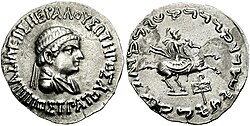Eastern territories
The descendants of the Greco-Bactrian king Euthydemus invaded northwestern India around 180 BC as far as the Punjab.

- Demetrius I (reigned c. 200–170 BC) Son of Euthydemus I. Greco-Bactrian king Coins
The territory ruled by Demetrius, from Bactria to Taxila, was then separated between western and eastern parts, and ruled by several sub-kings and successor kings. The Western part made of Bactria was ruled by a succession of Greco-Bactrian kings until the end of the reign of Heliocles around 130 BCE. The Eastern part, made of the Paropamisadae, Arachosia, Gandhara and Punjab, perhaps as far as Mathura, was ruled by a succession of kings, called "Indo-Greek":
Territories of Paropamisadae to Mathura (house of Euthydemus)
- Agathocles (190-180 BC) Coins
- Pantaleon (190-185 BC)
- Apollodotus I (reigned c. 180–160 BC)
- Antimachus II Nikephoros (160-155 BC)
- Demetrius II (155-150 BC)
The usurper Eucratides managed to eradicate the Euthydemid dynasty and occupy territory as far as the Indus River, between 170 and 145 BCE. Eucratides was then murdered by his son, thereafter Menander I seems to have regained all of the territory as far west as the Hindu-Kush
Territory from Hindu-Kush to Mathura (150 - 125 BCE)
- Menander I (reigned c. 150–125 BC). Successor to Apollodotus. Married to Agathocleia. Legendary for the size of his Kingdom, and his support of the Buddhist faith. Coins
- Agathokleia (r.c. 130-125 BCE), Probably widow of Menander, Queen-Mother and regent for her son Strato I. Coins
After the death of Menander I, his successors seem to have been pushed back east to Gandhara, losing the Paropamisadae and Arachosia to a Western Indo-Greek kingdom. Some years later the Eastern kings probably had to retreat even further, to Western Punjab.
Territory from Gandhara/Western Punjab to Mathura (125 - 100 BC)
- Strato I (125 - 110 BC) Coin, son of Menander and Agathokleia
- Heliokles II (110 - 100 BC) Coins
The following minor kings who ruled parts of the kingdom:
- Polyxenios (c. 100 BC - possibly in Gandhara)
- Demetrius III Aniketos (c. 100 BC).
After around 100 BCE, Indian kings recovered the area of Mathura and Eastern Punjab east of the Ravi River, and started to mint their own coins.
The Western king Philoxenus briefly occupied the whole remaining Greek territory from the Paropamisadae to Western Punjab between 100 and 95 BC, after what the territories fragmented again. The eastern kings regained their territory as far west as Arachosia.
During the 1st century BC, the Indo-Greeks progressively lost ground against the invasion of the Indo-Scythians, until the last king Strato II ended his ruled in Eastern Punjab around 10 CE.
Territory of Arachosia and Gandhara (95-70 BCE)
- Amyntas Nikator (95 - 90 BC) Coins
- Peukolaos (c. 90 BC)
- Menander II Dikaios "The Just" (90 - 85 BCE) Coins
- Archebios (90 - 80 BC) (with western Punjab) Coins
- ( Maues ), Indo-Scythian king.
- Artemidoros (c.80 BC) Coins.
- Telephos (75 - 70 BC) Coins
Territory of Western Punjab (95-55 BC)

- Epander (95 - 90 BC) Coins
- Archebios (90 - 80 BC) Coins
- ( Maues ), Indo-Scythian king
- Thraso (around 80 BC or earlier)
- Apollodotus II (80 - 65 BC) (with Eastern Punjab) Coins
- Hippostratos (65 - 55 BC) Coins, defeated by the Indo-Scythian King Azes I.
- ( Azes I ). Indo-Scythian king.
Around 80 BCE, parts of Eastern Punjab were regained again:
Territories of Eastern Punjab (80 BC - 10 AD)
- Apollodotus II (80 - 65 BCE)Coins
- Dionysios (65 - 55 BC)
- Zoilos II (55 - 35 BC)
- Apollophanes (35-25 BC)
- Strato II (25 BC - 10 AD) Coin
- ( Rajuvula ), Indo-Scythian king.
